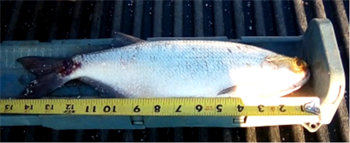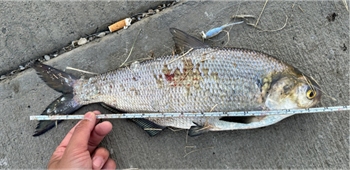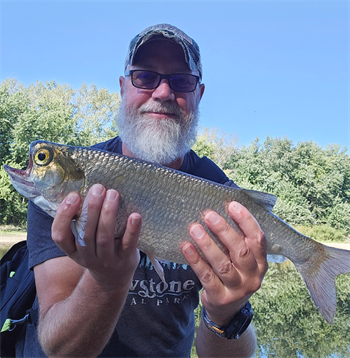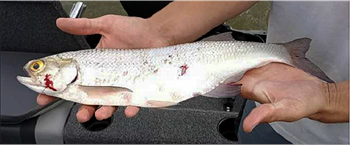Fish Iowa - Fish Species - Goldeye
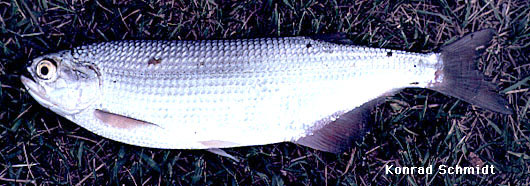
Characteristics
Deep, flattened body with a fleshy keel on the belly, but the scales are not jagged as in herrings. The body color ranges from dark blue to blue-green on the back with silvery sides and white belly. The iris of the eye is typically yellow to gold and there is an adipose eyelid present. The head is blunt and rounded with a large, oblique mouth. Teeth are present in both jaws, roof of the mouth and on the tongue. There are 15 to 17 gill rakers on the lower limb of the first arch. Scales are cycloid with a complete lateral line with 57 to 62 scales. The dorsal fin has 9 or 10 rays, and the anal fin has 29 to 34. The anal fin is sickle-shaped in mature males and bowl-shaped in females. An axillary process is present near the base of the pelvic fin.
Foods
Goldeye are mainly night feeders. The rods-only sight sensors in their eyes is very effective for seeing and foraging in the darkness of turbid water and at night. The fish are opportunistic foragers, eating nearly any organism available from insects, crustaceans, mollusks, and fish to frogs and small mammals.
Expert Tip
This fish often forages on the surface in shallow water.
Details
The Goldeye is most common in the muddy, open waters of medium to large-sized rivers with low gradient and firm sand substrates. In Iowa and Minnesota, it lives in quiet backwaters of larger streams and muddy shallows of lakes. The Goldeye is more tolerant of turbidity than the Mooneye, but avoids turbidity caused by industrial pollutants, as opposed to clay suspension. The habitat of the Goldeye has been reduced by impoundment, but it is often found hunting smaller fish in the swift waters below dams.
The Goldeye is primarily nocturnal and seeks gravelly, shallow shoal areas in flowing water or lakes to spawn. It spawns from May to July at 50 to 55 degrees. Mature Goldeyes move up tributary streams where spawning activity is random on gravel or firm bottom, usually in turbid water. The females deposit from 6,000 to 25,000 eggs that are .02 inch in diameter and semi-buoyant.
Goldeye reach up to 7-inches in the first year of life and 12-inches at maturity. Maximum size is about 14- to 16-inches.
Recent stream sampling information is available from Iowa DNR's biological monitoring and assessment program.
Sources:
Harlan, J.R., E.B. Speaker, and J. Mayhew. 1987. Iowa fish and fishing. Iowa Conservation Commission, Des Moines, Iowa. 323pp.
Loan-Wilsey, A. K., C. L. Pierce, K. L. Kane, P. D. Brown and R. L. McNeely. 2005. The Iowa Aquatic Gap Analysis Project Final Report. Iowa Cooperative Fish and Wildlife Research Unit, Iowa State University, Ames.
Photo Credit: photo courtesy of Konrad P. Schmidt, copyright Konrad P. Schmidt.
Distribution Map

Found in larger streams of western, southern and southeast portions of the state; it is not found in any interior waters of northeast Iowa. Widely distributed throughout the Mississippi and Missouri Rivers. Although never numerous, the Goldeye is widely distributed in Iowa and is not listed as a species of special concern.
See our most recent distribution data for this species on the Iowa DNR's Bionet application.
State Record(s)
Master Angler Catches
Fish Surveys
Tip: Click Species Length by Site, then use the dropdown to filter by fish species of interest.Where this Fish Is Found
Big Sioux River
Cedar River (Cedar Rapids to Moscow)
Cedar River (La Porte City to Cedar Rapids)
East Nishnabotna River
Iowa River (Columbus Junction to Mississippi R)
Little Sioux River (Correctionville to Missouri R)
Missouri River (Council Bluffs to state line)
Missouri River (Little Sioux to Council Bluffs)
Missouri River (Sioux City to Little Sioux)
West Nishnabotna River

